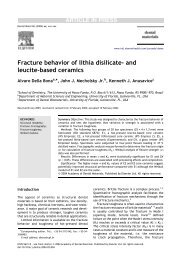Micro-tensile bond strength of adhesives bonded to class-I cavity ...
Micro-tensile bond strength of adhesives bonded to class-I cavity ...
Micro-tensile bond strength of adhesives bonded to class-I cavity ...
You also want an ePaper? Increase the reach of your titles
YUMPU automatically turns print PDFs into web optimized ePapers that Google loves.
1004<br />
J. De Munck et al.<br />
Figure 3 Feg-SEM <strong>of</strong> OptiBond FL. (a) Pho<strong>to</strong>micrograph <strong>of</strong> the fractured surface <strong>of</strong> a control specimen (s<strong>to</strong>red as mTBS<br />
stick in water for 20 days) at the dentin side. The specimen failed at the interface (I) and within the adhesive resin (Ar).<br />
(b) Composite counterpart <strong>of</strong> (a). (c) Pho<strong>to</strong>micrograph <strong>of</strong> the fractured surface <strong>of</strong> a thermo-cycling/<strong>cavity</strong> specimen at<br />
the dentin side. The specimen failed at the interface (I) and within the adhesive resin (Ar). (d) Higher magnification <strong>of</strong><br />
the composite counterpart <strong>of</strong> (c). The specimen failed at the <strong>to</strong>p <strong>of</strong> the hybrid layer (Hy), with the heads <strong>of</strong> the resin tags<br />
still attached <strong>to</strong> the adhesive resin. (e) Pho<strong>to</strong>micrograph <strong>of</strong> the fractured surface (dentin side) <strong>of</strong> a thermo-cycling/stick<br />
specimen. The specimen failed at the interface (I) and within the adhesive resin (Ar). (f) Higher magnification <strong>of</strong> (e) at<br />
an area that failed near the interface. The specimen actually failed at the <strong>to</strong>p <strong>of</strong> the hybrid layer (Hy).<br />
Figure 4 Feg-SEM <strong>of</strong> Clearfil Protect Bond. (a) Pho<strong>to</strong>micrograph <strong>of</strong> the fractured surface <strong>of</strong> a control specimen (s<strong>to</strong>red<br />
as mTBS stick in water for 20 days) at the dentin side. The specimen failed mainly near the interface (I), apart from a<br />
small part that failed within the adhesive resin (Ar). (b) Higher magnification <strong>of</strong> the composite counterpart <strong>of</strong> (a). The<br />
specimen failed within the hybrid layer (Hy). Some resin flashes (Ar) remained attached <strong>to</strong> the dentin side <strong>of</strong> the beam.<br />
(c) Pho<strong>to</strong>micrograph <strong>of</strong> the fractured surface (dentin side) <strong>of</strong> a thermo-cycling/<strong>cavity</strong> specimen. The specimen failed at<br />
the interface (I) and within the adhesive resin (Ar). (d) Higher magnification <strong>of</strong> the composite counterpart <strong>of</strong> (c). The<br />
specimen failed within the hybrid layer (Hy). (e) Pho<strong>to</strong>micrograph <strong>of</strong> the fractured surface (dentin side) <strong>of</strong> a thermocycling/stick<br />
specimen. The specimen failed at the interface (I) and within the adhesive resin (Ar). (f) Higher<br />
magnification <strong>of</strong> (e) at an area that failed near the interface. Again the specimen failed within the hybrid layer (Hy). No<br />
morphological differences with the control group could be observed.
















